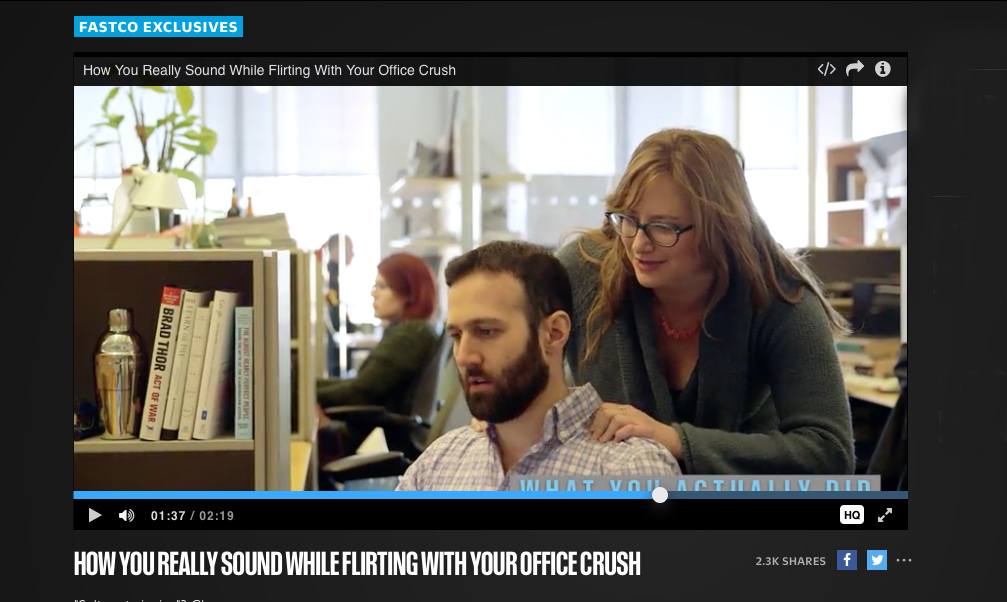Ever been a victim or culprit of awkward workplace flirting? A recent video from Fast Company demonstrates some of those common awkward moments that can occur with office crushes, like when you are trying to compliment the person’s new haircut, but instead say something uncomfortable, like “looks like sex hair.”
The video, titled “Office Crush Fails,” has gotten more than 2,000 shares on social media and represents a growing trend in online video.
Media organizations like Fast Company and The Atlantic are experimenting with ways to produce quick, shareable videos like this one, using humor, graphics and narrative storytelling to tell relatable stories, many that lean more toward satire than news.
“In order to get somebody to press play on something you need to have a lot to offer, and comedy is an easy way for people to know they’re going to enjoy it,” said Scott Mebus, head of video and television at Fast Company.
This is an approach made popular by BuzzFeed, a company not typically associated with traditional news. BuzzFeed videos range from lies people tell their exes to people trying foreign foods for the first time; they often draw huge audiences and lots of social media shares. Now other media companies are adapting BuzzFeed’s style to fit their own objectives.
BuzzFeed did not respond to emails or return phone calls from AJR.
Industry experts mostly applaud the growing video trend. Katie Hawkins-Gaar, digital innovation faculty at Poynter and former editor of CNN’s iReport, said BuzzFeed provides a useful example of how news organizations can use video to engage audiences and market content.
There always will be a market for more serious news content or long-from video in journalism, said Richard Koci Hernandez, assistant professor of new media at the University of California, Berkeley Graduate School of Journalism. But as long as the news is truthful and fact checked, the delivery is open to experimentation. When appropriate, he said, journalists “should loosen [their] ties a little bit.”
The BuzzFeed Video Effect
BuzzFeed is making the most of Internet consumers’ thirst for funny, relatable video content.
A narrative video released in August, titled “Weird Things All Couples Do,” is a good example. It follows two characters who are in a relationship and depicts relatable scenarios. The couple struggles to decide what to watch on TV at night, accidentally wear matching outfits and sing songs from musicals on car rides together. The video exceeded 3.1 million views.
In recent months, BuzzFeed created more videos in the same vein. “Things Everybody Does But Doesn’t Talk About,” for example, features President Obama taking selfies and practicing speeches in the mirror. Since its Feb. 12 release, it has racked up over 1.2 million likes and more than 500,000 shares on Facebook.
The goal of these videos is audience engagement and shareability, said Ze Frank, president of BuzzFeed Video, during a talk for Wired.co.uk in October. When making videos, BuzzFeed studies social behaviors, looking at what people are sharing, why they are sharing them and how people relate to certain topics or characters, Frank said.
Amusing Content with a Purpose
Fast Company’s Mebus said he thinks BuzzFeed’s goofy, relatable video format can be used successfully for other media platforms as well.
“Fast Company is proving that,” Mebus said. “I think anybody can do something like this, you just need to know what your brand is and stay true to that.”
Fast Company, a media company with a business and entrepreneurship focus, is pushing out mini-narrative videos similar to BuzzFeed’s, depicting different workplace scenarios. The videos are shared on social media, as well as Fast Company’s main site.
Mebus said he thinks the success of the videos lies in their relatability and humor, combined with a useful purpose.
“BuzzFeed sometimes gets a bad rap because they’re so mass. I actually think they’re pretty clever and we want to be clever too, but the thing that is important to us is service,” Mebus said. “Not just funny for funny’s sake, there’s also some value to it. … We’re weaving in stuff that people can actually use, but doing it in a fun, funny way.”
Fast Company’s videos offer examples of how viewers perhaps should be handling awkward office situations, versus how they probably are, Mebus said
Turning News into ‘Easily Digestible’ Video
Poynter’s Hawkins-Gaar said said she would love to see more journalists breaking down hard-to-understand news topics and turning them into quick, easily digestible video content. That kind of news can be informative, but still creative and fun, she said. Health is one serious subject news outlets could present in more creative ways, she noted.
“There’s plenty of stories where there’s an opportunity for news organizations to …show their sense of humor,” Hawkins-Gaar said.
Hernandez agreed that journalists should look outside the news realm to figure out how other media organizations are using video successfully.
“There’s exciting things going on the fringes of the industry that we should be paying attention to,” Hernandez said. “You look at the BuzzFeeds, you look at Vox, even look at what Snapchat is doing with the new Discover feature. It’s video. It’s short. It’s compelling. It’s complete. It’s concise. It’s short-form storytelling.”
Combining Information with a ‘Fun’ Video Format
The Atlantic is another news organization that seems to have figured out how to package news into a fun, successful video format. Its “If Our Bodies Could Talk” video series, hosted by senior editor James Hamblin, addresses science and health topics in a humorous way.
In a recent video, Hamblin travels to Google headquarters to find out how human skin is being used to develop technology for detecting cancer cells in the body. He presents useful information, but often relates to the subject matter with jokes or sarcasm. When Hamblin is about to enter one of Google’s life sciences labs, for example, he comments on it feeling “just like ‘Breaking Bad.’”
Hamblin said it can sometimes be difficult to approach topics like smoking or end-of-life care in a light-hearted way, but audiences seem to be responding to the videos very positively.
The “If Our Bodies Could Talk” series is The Atlantic’s most popular, according to Anna Bross, senior director of communications. She told AJR in an email that the most popular videos have been reaching almost 100,000 plays.
Hamblin, who comes from a stand-up and sketch comedy background, believes news outlets should be thoughtful about when to use humor. “I hope we’ve hit on something that works in incorporating entertainment into these videos, instead of just typical web videos that are just like ‘here’s information,’” he said. “I think there should be a reason that it is a video and not text. If it’s just pure information, most people might prefer to just read about it.”
Keeping it News-Appropriate
Not all news lends itself to funny videos, of course.
Hernandez said he is not a “big believer” in the idea that news needs to be made more fun to be engaging. Journalists have a responsibility, first and foremost, to tell stories in an honest way, he said, and humorous or shareable videos are not always a suitable option.
Hawkins-Gaar said some stories, like breaking news events and more serious hard news, may be inappropriate for short, amusing videos.
“It certainly depends on the topic,” Hawkins-Gaar said. “It’s something [journalists] have to consider as they’re creating stories: finding the right tone for the content.”








